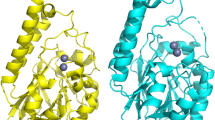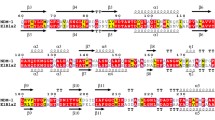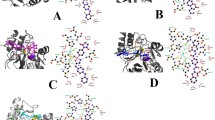Abstract
Metallo-β-lactamases (MBLs) are a family of Zn(II)-dependent enzymes that inactivate most of the commonly used β-lactam antibiotics. They have emerged as a major threat to global healthcare. Recently, we identified two novel MBL-like proteins, Maynooth IMipenemase-1 (MIM-1) and Maynooth IMipenemase-2 (MIM-2), in the marine organisms Novosphingobium pentaromativorans and Simiduia agarivorans, respectively. Here, we demonstrate that MIM-1 and MIM-2 have catalytic activities comparable to those of known MBLs, but from the pH dependence of their catalytic parameters it is evident that both enzymes differ with respect to their mechanisms, with MIM-1 preferring alkaline and MIM-2 acidic conditions. Both enzymes require Zn(II) but activity can also be reconstituted with other metal ions including Co(II), Mn(II), Cu(II) and Ca(II). Importantly, the substrate preference of MIM-1 and MIM-2 appears to be influenced by their metal ion composition. Since neither N. pentaromativorans nor S. agarivorans are human pathogens, the precise biological role(s) of MIM-1 and MIM-2 remains to be established. However, due to the similarity of at least some of their in vitro functional properties to those of known MBLs, MIM-1 and MIM-2 may provide essential structural insight that may guide the design of as of yet elusive clinically useful MBL inhibitors.






Similar content being viewed by others
References
Fisher JF, Meroueh SO, Mobashery S (2005) Bacterial resistance to beta-lactam antibiotics: compelling opportunism, compelling opportunity. Chem Rev 105:395–424
Davies J (1994) Inactivation of antibiotics and the dissemination of resistance genes. Science 264:375–382
Bebrone C, Lassaux P, Vercheval L, Sohier JS, Jehaes A, Sauvage E, Galleni M (2010) Current challenges in antimicrobial chemotherapy: focus on β-lactamase inhibition. Drugs 70:651–679
McGeary RP, Schenk G, Guddat LW (2014) The applications of binuclear metallohydrolases in medicine: recent advances in the design and development of novel drug leads for purple acid phosphatases, metallo-beta-lactamases and arginases. Eur J Med Chem 76:132–144
Maltezou HC (2009) Metallo-beta-lactamases in Gram-negative bacteria: introducing the era of pan-resistance? Int J Antimicrob Agents 33:405
Perez F, Hujer AM, Hujer KM, Decker BK, Rather PN, Bonomo RA (2007) Global challenge of multidrug-resistant Acinetobacter baumannii. Antimicrob Agents Chemother 51:3471–3484
Livermore DM, Woodford N (2006) The beta-lactamase threat in Enterobacteriaceae, Pseudomonas and Acinetobacter. Trends Microbiol 14:413–420
Crowder MW, Spencer J, Vila AJ (2006) Metallo-beta-lactamases: novel weaponry for antibiotic resistance in bacteria. Acc Chem Res 39:721–728
Page MI and Badarau A (2008) The mechanisms of catalysis by metallo beta-lactamases. Bioinorg Chem Appl 1–14
Phelan EK, Miraula M, Selleck C, Ollis DL, Schenk G, Mitić N (2014) Metallo-β-lactamases: a major threat to human health. Am J Mol Biol 4:89–104
Mitić N, Miraula M, Selleck C, Hadler KS, Uribe E, Pedroso M, Schenk G (2014) Catalytic mechanisms of metallohydrolases containing two metal ions. Adv Protein Chem Struct Biol 97:49–81, Elsevier, Oxford
Bebrone C (2007) Metallo-beta-lactamases (classification, activity, genetic organization, structure, zinc coordination) and their superfamily. Biochem Pharmacol 74:1686–1701
Bellais S, Girlich D, Karim A, Nordmann P (2002) EBR-1, a novel Ambler subclass B1 beta-lactamase from Empedobacter brevis. Antimicrob Agents Chemother 46:3223–3227
Yamaguchi Y, Takashio N, Wachino J, Yamagata Y, Arakawa Y, Matsuda K, Kurosaki H (2010) Structure of metallo-beta-lactamase IND-7 from a Chryseobacterium indologenes clinical isolate at 1.65-A resolution. J Biochem 147:905–915
Poirel L, Heritier C, Nordmann P (2005) Genetic and biochemical characterization of the chromosome-encoded class B beta-lactamases from Shewanella livingstonensis (SLB-1) and Shewanella frigidimarina (SFB-1). J Antimicrob Chemother 55:680–685
Yong D, Toleman MA, Giske CG, Cho HS, Sundman K, Lee K, Walsh TR (2009) Characterization of a new metallo-beta-lactamase gene, bla(NDM-1), and a novel erythromycin esterase gene carried on a unique genetic structure in Klebsiella pneumoniae sequence type 14 from India. Antimicrob Agents Chemother 53:5046–5054
Poirel L, Hombrouck-Alet C, Freneaux C, Bernabeu S, Nordmann P (2010) Global spread of New Delhi metallo-beta-lactamase 1. Lancet Infect Dis 10:832
Zhang H, Hao Q (2011) Crystal structure of NDM-1 reveals a common beta-lactam hydrolysis mechanism. FASEB J 25:2574–2582
Yang H, Aitha M, Marts AR, Hetrick A, Bennett B, Crowder MW, Tierney DL (2014) Spectroscopic and mechanistic studies of heterodimetallic forms of metallo-beta-lactamase NDM-1. J Am Chem Soc 136:7273–7285
Garau G, Bebrone C, Anne C, Galleni M, Frere JM, Dideberg O (2005) A metallo-beta-lactamase enzyme in action: crystal structures of the monozinc carbapenemase CphA and its complex with biapenem. J Mol Biol 345:785–795
Simona F, Magistrato A, Dal Peraro M, Cavalli A, Vila AJ, Carloni P (2009) Common mechanistic features among metallo-beta-lactamases: a computational study of Aeromonas hydrophila CphA enzyme. J Biol Chem 284:28164–28171
Bebrone C, Delbruck H, Kupper MB, Schlomer P, Willmann C, Frere JM, Fischer R, Galleni M, Hoffmann KM (2009) The structure of the dizinc subclass B2 metallo-beta-lactamase CphA reveals that the second inhibitory zinc ion binds in the histidine site. Antimicrob Agents Chemother 53:4464–4471
Costello A, Periyannan G, Yang KW, Crowder MW, Tierney DL (2006) Site-selective binding of Zn(II) to metallo-beta-lactamase L1 from Stenotrophomonas maltophilia. J Biol Inorg Chem 11:351–358
Ullah JH, Walsh TR, Taylor IA, Emery DC, Verma CS, Gamblin SJ, Spencer J (1998) The crystal structure of the L1 metallo-beta-lactamase from Stenotrophomonas maltophilia at 1.7 Å resolution. J Mol Biol 284:125–136
Hu Z, Periyannan G, Bennett B, Crowder MW (2008) Role of the Zn1 and Zn2 sites in metallo-beta-lactamase L1. J Biol Inorg Chem 130:14207–14216
Vella P, Miraula M, Phelan E, Leung EW, Ely F, Ollis DL, McGeary RP, Schenk G, Mitic N (2013) Identification and characterization of an unusual metallo-beta-lactamase from Serratia proteamaculans. J Biol Inorg Chem 18:855–863
Abriata LA, Gonzalez LJ, Llarrull LI, Tomatis PE, Myers WK, Costello AL, Tierney DL, Vila AJ (2008) Engineered mononuclear variants in Bacillus cereus metallo-beta-lactamase BcII are inactive. Biochemistry 47:8590–8599
Schenk G, Mitic N, Gahan LR, Ollis DL, McGeary RP, Guddat LW (2012) Binuclear metallohydrolases: complex mechanistic strategies for a simple chemical reaction. Acc Chem Res 45:1593–1603
Hadler KS, Mitic N, Ely F, Hanson GR, Gahan LR, Larrabee JA, Ollis DL, Schenk G (2009) Structural flexibility enhances the reactivity of the bioremediator glycerophosphodiesterase by fine-tuning its mechanism of hydrolysis. J Am Chem Soc 131:11900–11908
Thomas PW, Zheng M, Wu S, Guo H, Liu D, Xu D, Fast W (2011) Characterization of purified New Delhi metallo-beta-lactamase-1. Biochemistry 50:10102–10113
Riccio ML, Franceschini N, Boschi L, Caravelli B, Cornaglia G, Fontana R, Amicosante G, Rossolini GM (2000) Characterization of the metallo-beta-lactamase determinant of Acinetobacter baumannii AC-54/97 reveals the existence of bla(IMP) allelic variants carried by gene cassettes of different phylogeny. Antimicrob Agents Chemother 44:1229–12235
Pournaras S, Maniati M, Petinaki E, Tzouvelekis LS, Tsakris A, Legakis NJ, Maniatis AN (2003) Hospital outbreak of multiple clones of Pseudomonas aeruginosa carrying the unrelated metallo-beta-lactamase gene variants blaVIM-2 and blaVIM-4. J Antimicrob Chemother 51:1409–1414
Allen HK, Moe LA, Rodbumrer J, Gaarder A, Handelsman J (2009) Functional metagenomics reveals diverse beta-lactamases in a remote Alaskan soil. ISME J 3:243–251
Miraula M, Burnton CS, Schenk G, Mitić N (2013) Identification and preliminary characterization of novel B3-type metallo-β-lactamases. Am J Mol Biol 3:198–203
Shieh WY, Liu TY, Lin SY, Jean WD, Chen JS (2008) Simiduia agarivorans gen. nov., sp. nov., a marine, agarolytic bacterium isolated from shallow coastal water from Keelung, Taiwan. Int J Syst Evol Microbiol 58:895–900
Sohn JH, Kwon KK, Kang JH, Jung HB, Kim SJ (2004) Novosphingobium pentaromativorans sp. nov., a high-molecular-mass polycyclic aromatic hydrocarbon-degrading bacterium isolated from estuarine sediment. Int J Syst Evol Microbiol 54:1483–1487
Segel IH (1975) Enzyme kinetics: behavior and analysis of rapid equilibrium and steady state enzyme systems. Wiley, New York
Hadler KS, Tanifum EA, Yip SH, Mitic N, Guddat LW, Jackson CJ, Gahan LR, Nguyen K, Carr PD, Ollis DL, Hengge AC, Larrabee JA, Schenk G (2008) Substrate-promoted formation of a catalytically competent binuclear center and regulation of reactivity in a glycerophosphodiesterase from Enterobacter aerogenes. J Biol Inorg Chem 130:14129–14138
Crowder MW, Walsh TR, Banovic L, Pettit M, Spencer J (1998) Overexpression, purification, and characterization of the cloned metallo-beta-lactamase L1 from Stenotrophomonas maltophilia. Antimicrob Agents Chemother 42:921–926
Leiros HK, Borra PS, Brandsdal BO, Edvardsen KS, Spencer J, Walsh TR, Samuelsen O (2012) Crystal structure of the mobile metallo-beta-lactamase AIM-1 from Pseudomonas aeruginosa: insights into antibiotic binding and the role of Gln157. Antimicrob Agents Chemother 56:4341–4353
Gonzalez JM, Medrano Martin FJ, Costello AL, Tierney DL, Vila AJ (2007) The Zn2 position in metallo-beta-lactamases is critical for activity: a study on chimeric metal sites on a conserved protein scaffold. J Mol Biol 373:1141–1156
Paul-Soto R, Bauer R, Frere JM, Galleni M, Meyer-Klaucke W, Nolting H, Rossolini GM, de Seny D, Hernandez-Valladares M, Zeppezauer M, Adolph HW (1999) Mono- and binuclear Zn2+-beta-lactamase. Role of the conserved cysteine in the catalytic mechanism. J Biol Chem 274:13242–13249
Bebrone C, Anne C, De Vriendt K, Devreese B, Rossolini GM, Van Beeumen J, Frere JM, Galleni M (2005) Dramatic broadening of the substrate profile of the Aeromonas hydrophila CphA metallo-beta-lactamase by site-directed mutagenesis. J Biol Chem 280:28195–28202
Yanchak MP, Taylor RA, Crowder MW (2000) Mutational analysis of metallo-beta-lactamase CcrA from Bacteroides fragilis. Biochemistry 39:11330–11339
Dong YJ, Bartlam M, Sun L, Zhou YF, Zhang ZP, Zhang CG, Rao Z, Zhang XE (2005) Crystal structure of methyl parathion hydrolase from Pseudomonas sp. WBC-3. J Mol Biol 353:655–663
Lienard BM, Garau G, Horsfall L, Karsisiotis AI, Damblon C, Lassaux P, Papamicael C, Roberts GC, Galleni M, Dideberg O, Frere JM, Schofield CJ (2008) Structural basis for the broad-spectrum inhibition of metallo-beta-lactamases by thiols. Org Biomol Chem 6:2282–2294
Vella P, Hussein WM, Leung EW, Clayton D, Ollis DL, Mitic N, Schenk G, McGeary RP (2011) The identification of new metallo-beta-lactamase inhibitor leads from fragment-based screening. Bioorg Med Chem Lett 21:3282–3285
Heinz U, Bauer R, Wommer S, Meyer-Klaucke W, Papamichaels C, Bateson J, Adolph HW (2003) Coordination geometries of metal ions in d- or l-captopril-inhibited metallo-beta-lactamases. J Biol Chem 278:20659–20666
Schimerlik MI, Cleland WW (1977) pH variation of the kinetic parameters and the catalytic mechanism of malic enzyme. Biochemistry 16:576–583
Michalska K, Cielecka-Piontek J, Pajchel G, Tyski S (2013) Determination of biapenem in a medicinal product by micellar electrokinetic chromatography with sweeping in an enhanced electric field. J Chromatogr A 1282:153–160
Alekseev VG (2010) Acid–base properties of penicillins and cephalosporins (a review). Pharm Chem J 44:14–24
Smith SJ, Casellato A, Hadler KS, Mitic N, Riley MJ, Bortoluzzi AJ, Szpoganicz B, Schenk G, Neves A, Gahan LR (2007) The reaction mechanism of the Ga(III)Zn(II) derivative of uteroferrin and corresponding biomimetics. J Biol Inorg Chem 12:1207–1220
Hu Z, Spadafora LJ, Hajdin CE, Bennett B, Crowder MW (2009) Structure and mechanism of copper- and nickel-substituted analogues of metallo-beta-lactamase L1. Biochemistry 48:2981–2989
Linse S, Helmersson A, Forsen S (1991) Calcium binding to calmodulin and its globular domains. J Biol Chem 266:8050–8054
Permyakov EA, Yarmolenko VV, Kalinichenko LP, Morozova LA, Burstein EA (1981) Calcium binding to alpha-lactalbumin: structural rearrangement and association constant evaluation by means of intrinsic protein fluorescence changes. Biochem Biophys Res Commun 100:191–197
Clapham DE (2007) Calcium signaling. Cell 131:1047–1058
Brini M, Ottolini D, Cali T, Carafoli E (2013) Calcium in health and disease. Met Ions Life Sci 13:81–137
Bertini I (2007) Biological inorganic chemistry: structure and reactivity. University Science Books Sausalito, Sausalito
Stewart PS, Costerton JW (2001) Antibiotic resistance of bacteria in biofilms. Lancet 358:135–138
Acknowledgments
This work was supported in part by a research Grant from Science Foundation Ireland (SFI) under its PIYRA Programme, Grant Number 09/YI/B1756. G. S. acknowledges the award of a Future Fellowship from the Australian research Council (FT120100694) and is grateful to the National Health and Medical Research Council of Australia for funding.
Author information
Authors and Affiliations
Corresponding authors
Electronic supplementary material
Below is the link to the electronic supplementary material.
Rights and permissions
About this article
Cite this article
Miraula, M., Whitaker, J.J., Schenk, G. et al. β-Lactam antibiotic-degrading enzymes from non-pathogenic marine organisms: a potential threat to human health. J Biol Inorg Chem 20, 639–651 (2015). https://doi.org/10.1007/s00775-015-1250-x
Received:
Accepted:
Published:
Issue Date:
DOI: https://doi.org/10.1007/s00775-015-1250-x




